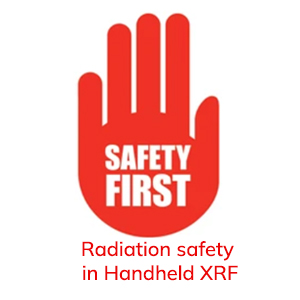How to use the XRF safely during analysis with the XRF, safety is the first priority for your own health and safety
Although the X-ray fluorescence (XRF) is generally safe during analysis, there are some safety precautions you should follow to minimize potential risks associated with exposure to X-ray radiation. During the analysis, the analyzer emits a directed radiation beam when the tube is energized (tube based instrument) or when the shutter is open (isotope based instrument). Reasonable effort should be made to maintain exposures to radiation as far below dose limits as is practical. This is known as the ALARA (As Low as Reasonably Achievable) principle. For any given source of radiation, three factors will help minimize your radiation exposure: time, distance, and shielding.
X-ray fluorescence (XRF) is a non-destructive analytical technique used to determine the chemical composition of materials. It is used extensively in the metal manufacturing, inspection and recycling industry. You might use it to identify the metal and alloys in a scrapyard, verify the content of your raw materials in your manufacturing plant, or check the gold content in a piece of jewelry.
Because this fluorescence is unique to the elemental composition of the sample, XRF is an excellent technology for qualitative and quantitative analysis of the material composition. While the radiation emitted from a portable XRF analyzer is similar to the exposure received in a normal medical or dental x-ray, care must be taken to always point a handheld XRF analyzer directly at the sample and never at a person or a body part
XRF occurs when a fluorescent (or secondary) x-ray is emitted from a sample that is being excited by a primary x-ray source. There are three factors will help minimize your radiation exposure: time, distance, and shielding. While the radiation emitted from a portable or handheld XRF elemental analyzer is similar to the exposure received in a normal medical or dental X-ray, care must be taken to always point a handheld XRF analyzer directly at the sample and never at a person or a body part. Here are seven safety tips:
- Provide radiation safety training to operators
- Never aim the device at yourself or others when the primary beam (x-ray on) lights are illuminated
- Never hold samples during analysis
- Be aware of primary beam indicator lights
- Handle and use with respect
- Store securely – obey local storage requirements
- If you have a Safety Emergency, notify your Radiation Safety Officer (RSO) and analyzer vendor
Here are some guidelines for using an XRF instrument safely during analysis:
- Training: Before using an XRF device, ensure that you have received proper training on its operation, safety precautions, and emergency procedures.
- Personal Protective Equipment (PPE): Wear appropriate PPE, such as safety glasses, gloves, and a lab coat, to minimize exposure to hazardous materials and radiation.
- Radiation safety: Make sure the XRF instrument is equipped with proper shielding to prevent X-ray leakage. Ensure the instrument is properly maintained and inspected regularly for signs of wear or damage.
- Warning signs and labels: Place warning signs in the area where the XRF is being used to alert others of the potential radiation hazard.
- Controlled access: Restrict access to the area where the XRF instrument is being used, and limit the number of personnel in the immediate vicinity.
- Maintain a safe distance: Keep a safe distance from the XRF instrument during operation, as recommended by the manufacturer, to minimize exposure to X-ray radiation.
- Interlock systems: Ensure that the XRF instrument is equipped with interlock systems that disable the X-ray source when the sample chamber is open or if any safety devices are triggered.
- Time and dose limits: Follow the As Low As Reasonably Achievable (ALARA) principle by minimizing the time spent near the XRF instrument and ensuring that your radiation dose remains below the recommended limits.
- Proper sample handling: Handle samples with care, and avoid touching them directly. Use tools, such as tweezers or forceps, to place and remove samples from the instrument.
- Emergency procedures: Familiarize yourself with the emergency procedures in case of an incident involving the XRF instrument, and know the location of first aid kits and other safety equipment.
- Proper disposal: Dispose of any waste materials generated during the analysis according to local regulations and guidelines.
- Documentation: Maintain records of the XRF instrument’s use, maintenance, and safety checks, as well as any personnel training or radiation exposure monitoring.
Source: https://www.thermofisher.com/blog/metals/7-safety-tips-when-using-handheld-xrf-analyzers-offered-for-isri-safety-stand-down-day/

